Teds in the 1955 documentary ‘Momma Don’t Allow’
The Fishmongers Arms, Wood Green, north-west London (Part 1)
I went searching for some details concerning the Fishmongers Arms, the first London venue played by Crazy Cavan and the Rhythm Rockers in the 1970s when I discovered it was the same venue portrayed in the short film ‘Momma Don’t Allow’. ‘Momma Don’t Allow’ was a 22-minute documentary filmed in early 1955 (but first screened in 25th January 1956). The subject of the film was the Wood Green Jazz Club run by Art & Viv Sanders and housed in the Bourne Hall, a wooden shed attached to the Fishmongers Arms, Wood Green, north-west London. This film has its importance for us for being one of the earliest – maybe the earliest – film portrayals of teddy boys.
This was an early short film by Karel Reisz’s and Tony Richardson, leading lights in the independent Free Cinema movement of the time. A number of short documentaries focusing on aspects of 50s Britain were completed. Initially these films were funded by the BFI (such as ‘Momma Don’t Allow’ and Lindsay Anderson’s earlier ‘O Dreamland’ (1953)), but by 1957 both Reisz and Anderson were – bizarrely – funded to make similar short documentaries by the car manufacturer Ford (from which we get Reisz’s own ‘We Are the Lambeth Boys’ (1959)). By the later 50s, Richardson and Reisz had moved on to full-length feature films imbued by the emerging realistic ‘kitchen sink drama’ ethos in which working class life was portrayed more realistically than ever before: Richardson leading with Look Back in Anger and Reisz with Saturday Night, Sunday Morning (1960). Anderson would join them in directing feature films in 1963 with This Sporting Life; although he is best remembered for his seminal attack on the British establishment If … (1968).
The ‘documentaries’ filmed by the Free Cinema film-makers were not always simply a depiction of what was actually happening but were staged ‘naturalistically’, and this needs to be kept in mind when analysing the film (more on this below).
Part 2 – Summary and further analysis of ‘Momma Don’t Allow’
You might like to see the ‘Momma Don’t Allow’ for yourself; it is on YouTube in two instalments (parts 1 & 2).
Here follows an outline of its ‘plot’ by Christophe Dupin from the BFI Screen Online site, with some additions by me between square brackets (the letters A and B of the timing references refer to the first and second instalments of the film available on YouTube):
[A0:00–4:15] Chris Barber’s jazz band unpack their instruments and rehearse for the evening concert at the Wood Green Jazz Club in North London. Meanwhile, [interspersed with the rehearsals] young working-class people – a waitress, a butcher boy, a dentist’s assistant [and her boyfriend] – leave their work and head for the club.
[A4:15] There, a crowd of youngsters are queuing to get in as the band starts playing. Teddy boys order their first pint, joke with their friends and flirt with girls [A6:16] while the first couples move towards the dance floor.
[A9:20–B6:17] The friendly atmosphere is only disrupted by the arrival of a group of upper-class people out on a “slumming night”. They show off their expensive cars, suits and evening dresses and look at the working-class youngsters with amusement and contempt [I’d interpret it as bemusement …]. When it comes to dancing, they seem less self-assured, but everybody treats them with indifference. They leave the club as the evening goes on.
[B6:17] On stage the band alternates boisterous jazzy tunes and slower ballads sung by a female singer. Between two songs some couples progressively get closer, hug each other and kiss. Others have a row and then make up. A girl falls asleep on her boyfriend’s shoulder. On the dance floor the most active youngsters accelerate their pace and only stop jiving when the band decides to pack up. The revellers go home, exhausted but happy.
It must be kept in mind that the film was not simply shot as it happened one evening but was in fact shot over nine Saturdays at Wood Green Jazz Club [SandyBrown]. Some of the people portrayed were evidently ‘cast’, notably the arguing couple scene, some of the dancing and probably the teds. As far as dancing is concerned, the commentator *IendeavourAlways [YT comment] states: “I was there. One of the lead couples in the film was my elder brother and his then fiance. The filming rather ruined the atmosphere of the club for a few days because of the bright lights they had to use.” Another commentator, Dan Lucken [SandyBrown], testifies that: “After dancing all evening, we would travel home on the 233 bus to Park Lane, Tottenham, where we both lived. We were recruited as extras for the dance scenes in ‘Mama Don’t Allow’ which was filmed on a Saturday morning in the hall … There was no live band – the music played was pre-recorded. So the film must have been put together in the edit room, where they seem to have ‘lost’ my contribution. We were paid, well, I was, £2 cash – a lot of money then, plus a free lunch in the pub.” This is enough to warn us that a portion of what we see in the documentary is stage rather than real.
Part 3 – The music, the teds and the rest of the audience
The band playing in the documentary is the well-known Chris Barber Jazz Band (featuring soon to be famous Lonnie Donegan of ‘Rock Island line’ fame; he is seen a number of times playing his banjo [A1:09]). The music seems to be mostly dixieland or traditional jazz instrumentals, varying with a sultry blues ballad sung by a woman and what, towards the end, can only be classed as skiffle, the song ‘momma don’t allow’ which sends the audience into a frenzy and – significantly – gives its name to the film. Clive Harper [YT comment] notes that the dance in film: “is called Trad Jive. You jive to the off beat, on a slow blues like that played at the start you can double the speed you dance, it is like skipping to the music, on a fast number you can do the reverse. It takes a while to learn but when it clicks it’s magic, It happened to me at an allnighter in Ken Colyers club in Great Newport St. Try it.” A brief view of home-made poster on wall [A8:29] presumably advertises gigs by George Melly and what seems to be another jazzman Alex Welsh.
One of the staged scenes in the film is the entrance, participation and exit of the “middle-class” contingent of four (two men and two women) ‘slumming it’. These are definitely not middle class but upper-class Hooray Henries arriving chauffered in their posh Hispano Suiza and the women have fur-lined coat and pearl necklaces and a poodle – what could be clearer!? *Alastair Scott Sutherland [YT comments] seems to be right in identifying the tallest of the men as the journalist Ian Dunlop, an art correspondent. Dunlop’s obituary in The Telegaph (17.08.2012), gives his birth date as 1929 and describes him as a hedonist and a womaniser who was a habituee of Soho. The Telegraph obituary paints this portrait of him: “Tall and lanky, patrician in physiognomy, speech and mien (in his fifties he was dubbed ‘The Greying Mantis’), Dunlop saw himself as a ladies’ man. Girls who had been stood up by feckless or faithless men were his speciality, and his hit ratio was high.” When ‘Momma Don’t Allow’ was filmed he was aged 26 which hardly makes him a teenager and the year in which he married his wife (who may well be his dance partner here). One can’t help but think that his appearance in the film came about through him and the film-makers being acquainted with one another.
Interestingly, Dunlop – if it is him – is wearing what must be a long velvet-collared overcoat and a bowler hat [A9:19; B5:56].
When he’s in the dance hall he’s no longer seen wearing the velvet-collar, rather a more non-descript suit whose jacket with a chequered pattern [A10:43; A11:20; A11:47; B0:05; B2:39: B3:25]. He seems to be an Edwardian in the original upper-class reification of this fashion, as found by the openly homosexual dandy and tailor ‘Bunny’ Roger who championed this trend in the early 1950s (think Steed of the ‘Avengers’ tv series).
As for the teds, they’re not that easy to spot, a cursory look at the film didn’t bring it out to me that there were teds there since they are not as distinguishable from the general male population as they later would become.
At [A6:43–54] we see the first one whom we’ll call ‘the 1st ted’. he’s certainly the first velvet-collared one. He’s entering the dance hall, he’s particularly cheerful and he goes through the crowd to his mates, none of whom are velveted.
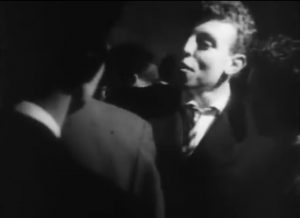
We see ‘the 1st ted’again at [A8:02–06] – without velvet, so obviously filmed on another occasion, continuity mistakes – with his mates forcing women entering the dance hall to run a gauntlet of their advances or cheeky comments.
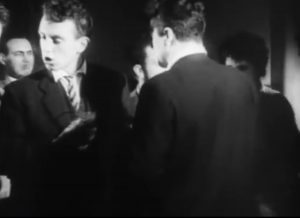
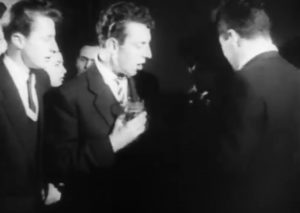
At [A9:03–18] ‘the 1st ted’ is jiving in the time-honoured style without looking at his partner (we soon see that the girl’s white polo-neck sports a musical stave pointing her out as a fan of rhythmic dance music – rock’n’roll was not yet applied to such music).
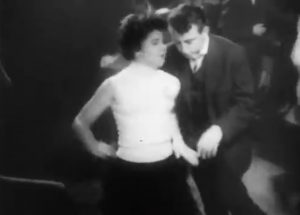
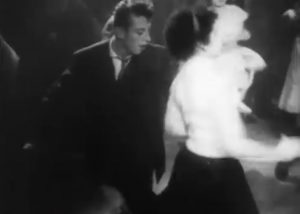
Soon after we’ve seen the first ted, we see [A07:38] a group of blokes chatting to each other, one of whom, velvet-collared we’ll call ‘the 2nd ted’ (on the left) and another (on the right) who – although it’s indistinguishable at this point in the film – whom we recognise later as the one wearing a jacket with something that appears to be a shawl-collar (probably not velvet).
During ‘the 1st ted’’s jiving sequence [B05:11], his mates are watching very closely (note the ‘2nd ted’ on left, and he whom we’ll call ‘shawl-collar ted’ to his right, egging him on).
They each dance with the girl in turn (first ‘shawl-collar ted’ [B05:31] then ‘the 2nd ted’ [B07:13; B07:18]).
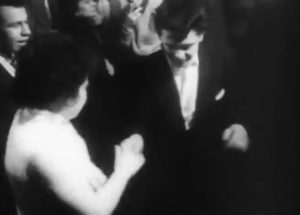
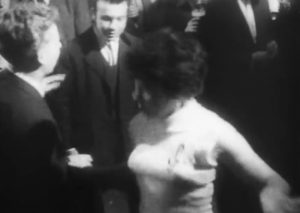
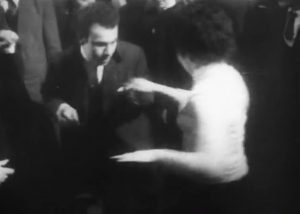
Yet another lad dances with the girl and he is egged on by ‘the 1st ted’ and ‘shawl-collar ted’ [B07:42; B07:53] (we see a close-up of ‘shawl-collared ted’ buttoned-up and with a tie this time due to a lack of continuity at [B:08:38]).
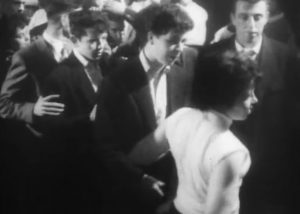
While ‘music-loving girl’ is dancing with the ‘ted gang’ we see, in the immediate background another, unrelated velvet-collared ted, dancing with a girl [B08:22; B08:43] (in the second screengrab his quiff is downfallen).
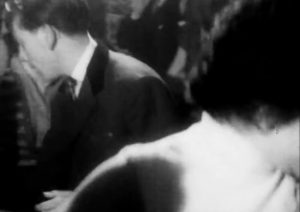
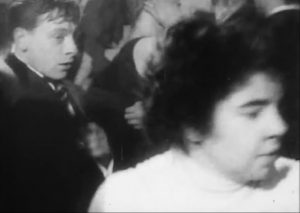
In 1953 ‘Edwardian’ Leonard Sims explained to readers of the Daily Mirror that “Our idea of a good night out is to dance at the jazz clubs.” < www.edwardianteddyboy.com/page16.htm >. ‘Momma Don’t Allow’ illustrates this exactly, showing, as it does, teds attending jazz nights and listening to and dancing to dixieland and to skiffle in 1955, but this is not to say that all people who attended such clubs were teds, far from it. It is true that teds are the more difficult to distinguish for us since most young men in 1955 were sporting what can be considered quiffs. The evidence of the film is that most of the young men at the dance are not teds, since they are sporting all sorts of different styles, ordinary 50s suits, shirts or pullovers. No particularly long jackets are in evidence (although there are some overcoats). The difficulty of identifying teds is evident in the character of the butcher boy, whose presence re-occurs from time to time, and seems to us today a ted, but maybe he was just an ordinary bloke of 1955 as he is depicted in the film as simply going out with his girlfriend and not associated with any ‘gang’ (the two screengrabs shown [A04:55; A08:39] may point to continuity problems unless there is a misidentification here).
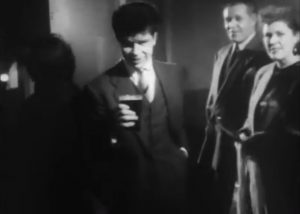
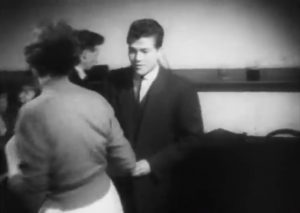
Now there is no doubt that the velveted collar types in the film are teds, genuine ones at that, but it is also clear that their ‘gang’ are not all wearing Edwardian gear, at least not velvet collars or long drapes. This is probably the true picture of many 50s ‘ted gangs’, only a few were geared up the whole way but if they behaved rowdily their identification as teds would depend on only some of the individuals.
Analysing the film’s images – none of the characters are heard speaking – and knowing what we do of the making of this film we can suspect a certain amount of staging in the scenes in which the ‘teds’ appear. It is clear that the rowdiness of the ‘teds’ in the film (not only the velvet-collared ones) was presented by the film-makers in a way in which they contrast to most of the audience who are busy dancing or listening to the music (some being clearly middle class, as we know from other sources). What’s more, there’s a suggestion that the girl who’s willingly jiving with all the ‘teds’ is slightly ‘immoral’ as she stands in contrast to most other dancers who are portrayed as couples (albeit a falling out is shown). Another pointer to the ‘rowdiness’ of the ‘teds’ is that they are brought into prominence towards the end as the band plays the skiffle ‘Momma Don’t Allow’ and the whole audience is shown to get frenetic.
Much of these comments are my interpretation of what we are seeing. I may be wrong on a number of accounts so take me to task if you think I’m mistaken. Irrespective of what I say, take a look at the film for yourselves and add your own comments to this thread.
Another thing strikes me looking at these screengrabs. As delicate as it is to distinguish teds from non-teds, is it true that the ‘ted gang’ in this film is wearing darker jackets than most of the other participants?
Part 4 – The Bourne Hall’s (Fishmongers’ Arms) illustrious history
The Bourne Hall had been used as a local dance hall since the 1920s before Art and Viv Sanders became the Wood Green Jazz Club around 1947–48 remembers Bunny Austin. Alan Davis a frequenter of the late 1950s remembers that “By watching various couples dancing I learnt to skip jive and stomp in the traditional jazz style. The girls very rarely refused to dance and many were students of Hornsey Art College and were very friendly.” [SandyBrown]. Roy Bowker [YT comment] in reference to the mid 50s commented that at the: “’Bourne Hall’ at the back of the Fishmongers Arms pub. Every Sunday evening. The walls used to run with condensation so if you put your coat on the ledge it got soaking wet by the end of the evening. Great times stomping with your foot going up and down.” Roy Beiley [YT comment] remembers “I was courting a girl in 1962 who introduced me to the Wood Green Jazz Club. … Although it was a few years after the time this film was shot, the atmosphere inside didn’t seem to have changed much although the number of ‘DA’s’ sported by the lads and the full skirt dresses of the girls had reduced. Jiving to traditional jazz bands was simply exhilarating. … my two grand-daughters … could not believe that the band members and the lads all looked so formal in their suits with ties in the 1950’s and 1960’s at such events.”
Part 5 – The 1960s change from a jazz club to a rhythm’n’blues and then a pop venue and rehearsal studio
It remained a jazz club well into the 1960s but John Cox (who frequented the club between 1960–68) saw it slowly metamorphose from a ‘trad jazz’ venue to a rhythm and blues venue (Mike Cotton having been the main instigator of this change) [SandyBrown]. At the Fishmongers Arms Club, trad jazz was the staple Sunday night fare and a new strain of R&B began on the quieter Tuesday nights. As fashions changed during the 1960s the R&B sessions became ever more popular and the pub began to host gigs by contemporary blues and rock musicians – many of them part of the blues renaissance of the mid to late sixties [McKeever 2012]. It continued as a music venue into the 1960s with some high profile performers such as John Mayall, Eric Clapton, Long John Baldry, Joe Cocker, Rod ‘The Mod’ Stewart, Fleetwood Mac, The Kinks, Cream, Led Zeppelin, Jethro Tull, and Pink Floyd amongst others. In 1972 it was described by John Pidgeon, a film and music journalist, as “one of those legendary London music pubs where countless bands had played the blues before they became famous.” He described the venue then as a “draughty hall in need of refurbishment, its décor untouched for at least a decade, judging from the scraps of posters here and there advertising bands that once must have packed the place. Wall-to-wall bodies would be the only way to have warmed this tatty venue, I speculated, because the stingy radiators weren’t up to it.” In truth, by the early seventies there were fewer regular live performances and the Bourne Hall became used as a daytime rehearsal space and audition studio for London bands [McKeever 2012].
Part 6 – The early 1970s ‘Hound Dog’ rock’n’roll revival club
From the early 1970s The Fishmongers had become a rock’n’roll revival club called ‘The Hound Dog’ [McKeever 2012]. *Mrarryboy [YT comment] remembers “many happy evenings at the Fishmongers Arms when it was a rock n roll venue (1970’s) – wonderful times dancing to the likes of Crazy Cavan, Flying Saucers and many others. When it shut down we used to frequent the Kings Head in Edmonton. lmao … happy days. / [In] 1969 I was a greaser (but I secretly liked bluebeat and ska etc. – along with the obligatory rock and roll for us greasers, lol).” John Collis, in his book Gene Vincent and Eddie Cochran: Rock’n’roll Revolutionaries (2011) – which details the two rockers’ ill-fated British tour of 1960 – it is revealed that it was at the Fishmongers Arms that Gene Vincent was served with a court order for proceedings to resolve non-payment of child maintenance to his third wife Margie. Vincent was to make one more visit to the Fishmongers Arms, (by this time the Hound Dog Rock and Roll revival club) as he attempted to rebuild his career in the early seventies – shortly before his death [McKeever 2012].
I’ve no idea who ran the Hound Dog club at the time. It would be nice to know.
POSTED August 2015.
SOURCES: BFI Screen Online site ‘Momma Don’t Allow’ < www.screenonline. org.uk/film/id/439003 >. Commentators on YouTube and on the Sandy Brown Jazz article < www.sandybrownjazz.co.uk/forumwoodgreen.html >. Richard McKeever. 2012. ‘Our Musical Heritage: Live at the Fishmongers Arms’ < www. bowesandbounds.org/profiles/blogs/fishmongers-arms-live-music >. The Telegaph (17.08.2012) < www.telegraph.co.uk/news/obituaries/9483322/Ian-Dunlop.html >
You can get the ‘Momma Don’t Allow’ film on a British Film Institute three DVD set called ‘Free Cinema’ (£21.45 from Amazon or cheaper used copies).
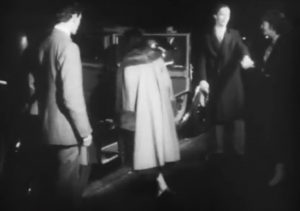
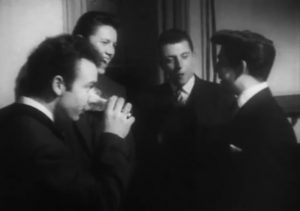
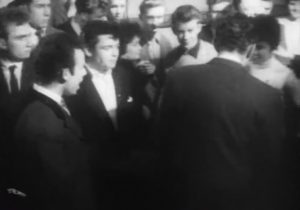
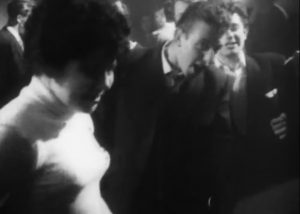
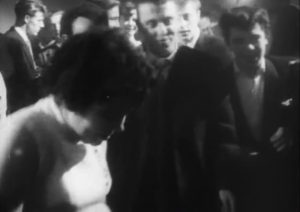
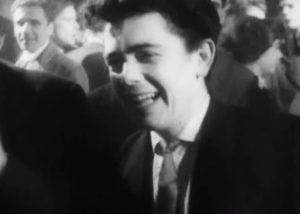
Post Comment